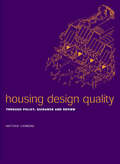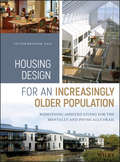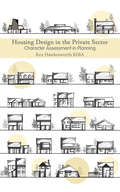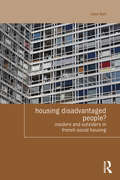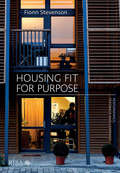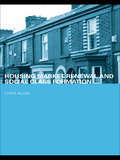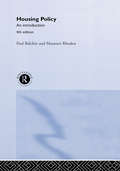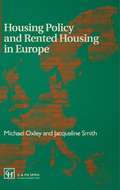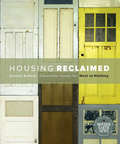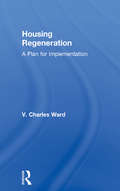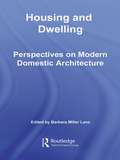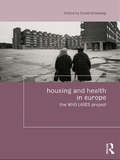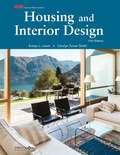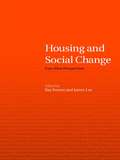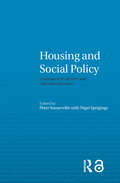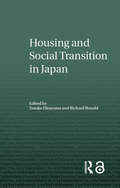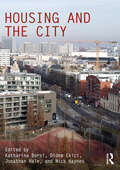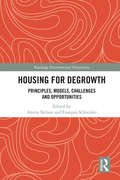- Table View
- List View
Housing Decisions
by Evelyn L. Lewis Carolyn S. TurnerGives students the guidelines they will need to make wise housing choices.
Housing Decisions
by Evelyn L. Lewis Carolyn S. TurnerHousing Decisions is designed to encourage a broad understanding and appreciation of the housing and interior design fields. Topics will lead you through the many issues faced when selecting and personalizing a home. Various housing and design options are presented to help you recognize the wide variety of choices available for addressing different needs and life situations.
Housing Decisions
by Evelyn L. Lewis Carolyn S. TurnerLewis (emeritus, home economics, Northern Arizona U. , Flagstaff) and Turner (housing research, North Carolina Agricultural and Technical State U. , Greensboro) address numerous aspects of housing including related careers. This textbook's 7th incarnation (the last being in 2000) features color illustrations, relevant US legislation, energy-saving tips, and a glossary.
Housing Design Quality: Through Policy, Guidance and Review
by Matthew CarmonaThis book directly addresses the major planning debate of our time - the delivery and quality of new housing development. As pressure for new housing development in England increases, a widespread desire to improve the design of the resulting residential environments becomes evermore apparent with increasing condemnation of the standard products of the volume housebuilders.In recent years central government has come to accept the need to deliver higher quality living environments, and the important role of the planning system in helping to raise design standards. Housing Design Quality focuses on this role and in particular on how the various policy instruments available to public authorities can be used in a positive manner to deliver higher quality residential developments.
Housing Design for an Increasingly Older Population: Redefining Assisted Living for the Mentally and Physically Frail
by Victor Regnier“Longer lifespans and the needs of the oldest old are challenging the senior living industry to find bold and compassionate solutions to combine programs and services with housing. Victor Regnier's latest research provides a thoughtful and insightful roadmap that arrays new ways of thinking from small-scale settings to community based options. International case studies offer possible solutions with the best thinking from around the globe…all with Vic's unique perspective of extracting themes and concepts that are broadly applicable and essential to addressing the needs of those that live on life's fragile edge.” —David Hoglund, FAIA “Supporting the independence of the oldest-old is a tough problem Victor Regnier addresses in his latest book on aging and housing. Like previous work, Victor relies on the best practices of northern Europeans to outline a three-prong approach. First, providing extremely comprehensive home care services in an "apartment for life" setting. Second, reforming the conventional nursing home by exploring small group style accommodations. Third, combining new technology with community based services to age in place. Case studies document the experiences of others in making these programs work here and abroad. The magnitude of the 90+ and 100+ population increases in the next 50 years make it clear how important it is to address this concern today.” —Edward Steinfeld Darch “The movement of health care from the institution to the home is a theme that Regnier identifies as one of the most important lessons in rethinking the issue of how to support the ever growing and increasingly aged older population here and abroad. He examines simple but profound approaches we can take in making long-term care a more humane proposition. Familiar themes like humanizing technology and optimizing the impact of the natural environment are brought together with clear policy thinking about what we need to do. The timing is good because the impact of this growing segment of society will have major repercussions on health care for the next 50-70 years.” —Stephan Verderber, Ph.D. A comprehensive guide to designing housing for the world’s aging population The dilemma of helping older people maintain their independence through better housing with services is growing. This book presents innovative solutions for those who create and provide housing for the world’s increasingly longer-living population. By focusing on three specific housing and service arrangements, it offers alternatives that provide greater freedom of choice than the current living arrangements that exist today. It presents selected examples of housing and service solutions from the US, Sweden, Denmark and the Netherlands to stimulate thinking about the possibilities of community-based service models. Housing Design for an Increasingly Older Population looks at a trio of options for housing the “oldest-old:” the Dutch Apartment/Condo for Life Model (AFL); decentralized Small/Green Houses; and the provision of enhanced personal and health care for people who want to stay in their own home. It offers unique and eye-opening chapters covering: what older people want; what age changes affect independence; demographics and living arrangements; how long-term care is defined; concepts and objectives for housing the frail; care giving and management practices that avoid an institutional lifestyle; innovative case studies; programs that encourage staying at home with service assistance; therapeutic use of outdoor spaces; how technology will help people stay independent; and more. Based on the author’s numerous conversations with other experts, as well as his examinations of high quality settings from Northern Europe and the US Building case study examp
Housing Design in the Private Sector: Character Assessment in Planning
by Rex Hawkesworth RibaNever before has house design been a science; it has always been a subjective desire of a rich person who can throw money away to achieve a personal satisfaction of something for him or her. At the opposite end of scale, i.e., housing for ordinary people, you only have to look at Victorian slums to see the outcome - profit. It is not normal for householders to consider the buyer much more than a chance of bathroom or kitchen fittings. Smaller developers are more liable to consider the buyer, provided, of course, the design is straightforward and economical. If densities are met, the architect can probably plot his or her artistic thoughts even more. Therefore, modern housing generally has a traditional look about it. Beyond that, design initiatives are hidden or subtly designed so that the client's vision is not interfered with; a greater depth of understanding is produced if adjoining sites or buildings are taken into account to add sensibility or satisfaction to the design, but this can only be achieved in individual designs and not estates. This is what this book is all about: making the most of the site and its neighbours.
Housing Disadvantaged People?: Insiders and Outsiders in French Social Housing (Housing and Society Series)
by Jane BallSocial housing appears to offer a solution for the housing of poor and disadvantaged people. The French "right to housing" offers poor and disadvantaged citizens priority in social housing allocation, and even a legal action against the State to obtain a social home. Despite this, France is suffering a long-lasting housing crisis with disadvantaged people having particular difficulties of access, often despite the efforts of local housing actors. This situation is affected by the European Court of Human Rights and EU decisions limiting diverse national housing and rental policies. Between historic French revolutions and the modern riots, negotiated solutions to social dilemmas emerged. Despite progress in constitutional principles, complex local negotiations still ultimately determine who is housed. Local social landlords, mayors and employee and tenant representatives use their privileges to house their insiders: existing tenants, locals and employees, with rent insufficiently subsidized. ‘Insider Outsider’ theory is used for an economic analysis of exclusion in social housing allocation: its processes, institutional context, and stigmatizing effects. This highlights the spatial effects of nimbyism, excluding disadvantaged outsiders, and concentrating them in deprived areas. Simultaneously, urban regeneration reduced affordable housing stock and ‘social mix’ became a reason to refuse a social home. History, comparative law, economic theory and local interviews with housing actors give a detailed picture of what happens in and around French social housing allocation for an interdisciplinary housing policy audience. Constitutional principles appear in an unfamiliar guise as negotiating positions, with the "right to property" supporting landlords and the "right to housing" supporting tenants. French debates about the function of social landlords are echoed across Europe and reflected in European policies concerning rights, and the exclusion of disadvantaged minorities.
Housing Fit For Purpose: Performance, Feedback and Learning
by Fionn StevensonHousing Fit for Purpose sets out a research-focused approach to looking at the challenges facing the built environment in approaching the design, construction and management of housing. This book uses original research by the author on housing performance evaluation and distils it for built environment professionals, arguing that learning from feedback should be taking place at every stage of the housing project lifecycle, improving outcomes for end users. Drawing on active research, this book shows why and how the design, construction and management of housing can be linked to feedback and actual evidence of how people choose, and learn, to use their homes. It examines the key concepts which underlie participatory design, occupancy feedback and learning, and includes a practical primer on how to undertake housing occupancy feedback.
Housing Market Renewal and Social Class (Housing, Planning and Design Series)
by Chris AllenHousing market renewal is one of the most controversial urban policy programmes of recent years. Housing Market Renewal and Social Class critically examines the rationale for housing market renewal: to develop 'high value' housing markets in place of the so-called 'failing markets' of low-cost housing. Whose interests are served by such a programme and who loses out? Drawing on empirical evidence from Liverpool, the author argues that housing market renewal plays to the interests of the middle classes in viewing the market for houses as a field of social and economic 'opportunities', a stark contrast to a working class who are more concerned with the practicalities of 'dwelling'. Against this background of these differing attitudes to the housing market, Housing Market Renewal and Social Class explores the difficult question of whether institutions are now using the housing market renewal programme to make profits at the expense of ordinary working-class people. Reflecting on how this situation has come about, the book critically examines the purpose of current housing market renewal policies, and suggests directions for interested social scientists wishing to understand the implications of the programme. Housing Market Renewal and Social Class provides a unique phenomenological understanding of the relationship between social class and the market for houses, and will be compelling reading for anybody concerned with the situation of working class people living in UK cities.
Housing Policy In The United States: An Introduction
by Alex F. SchwartzHousing Policy in the United States is an essential guidebook to, and textbook for, housing policy, it is written for students, practitioners, government officials, real estate developers, and policy analysts. It discusses the most important issues in the field, introduces key concepts and institutions, and examines the most important programs. Written as an introductory text, it explains all concepts, trends, and programs without jargon, and includes empirical data concerning program evaluations, government documents, and studies carried out by the author and other scholars. The first chapters present the context surrounding US housing policy, including basic trends and problems, the housing finance system, and the role of the federal tax system in subsidizing homeowner and rental housing. The middle chapters focus on individual subsidy programs. The closing chapters discuss issues and programs that do not necessarily involve subsidies, including homeownership, mixed-income housing, and governmental efforts to improve access to housing by reducing discriminatory barriers in the housing and mortgage markets. The concluding chapter also offers reflections on future directions of US. housing policy.
Housing Policy and Rented Housing in Europe
by Michael Oxley Jaqueline SmithThe book will inform a wide audience about the provision of rented housing in several European countries. The material is relevant to many housing, surveying and planning undergraduate and postgraduate courses which have a European housing element/option.
Housing Reclaimed
by Jessica KellnerHousing is a fundamental human right. For most of human history, our homes were built by hand from whatever local materials were available. However, since the Industrial Revolution, most housing has become little more than quickly constructed, mass-produced, uniform boxes. At the same time, the invention and standardization of the thirty-year mortgage and our ever-increasing reliance on credit has come to mean that most of us never own our homes outright.Housing Reclaimed is a call to arms for nonconventional home builders. It examines how technological advances, design evolution, and resourceful, out-of-the-box thinking about materials and efficiency can help us meet the challenge of building affordable, environmentally friendly, beautiful, and unique homes. Focusing on the use of salvaged and reclaimed materials, this inspirational volume is packed with case studies of innovative projects including:*Phoenix Commotion-working together towards low-income home ownership through sweat equity and 100 percent recycled materials*HabeRae-revitalizing neighborhoods by creating urban infill using modern technology and sustainable and reclaimed materials*Builders of Hope-rescuing and rehabilitating whole houses slated for demolitionThese projects and others like them demonstrate that building one's own home does not have to be an unattainable dream. This beautifully illustrated guide is a must-read for anyone interested in creating quality zero- or low-debt housing, reducing landfill waste, and creating stronger communities.Jessica Kellner is the editor of Natural Home and Garden magazine and a passionate advocate of using architectural salvage to create aesthetically beautiful, low-cost housing.
Housing Regeneration: A Plan for Implementation
by V. Charles WardWritten from an ‘in house’ perspective in response to the UK Government Housing White Paper released in February 2017, Housing Regeneration: A Plan for Implementation presents sustainable solutions to Britain’s housing crisis and will be a useful practical guide for anyone involved in the process of regeneration. Taking as its starting point an idea for a housing regeneration scheme, it provides an overview of each of the issues to be considered and the options for addressing them. In clear and concise language, it explains the issues and work involved in a regeneration scheme, answering questions such as who is involved, how is it paid for, what options are available and, importantly, what are the risks. It will appeal to lawyers, councillors, town planners, surveyors, chief officers, finance officers, procurement officers, project managers and students, amongst others.
Housing Transformations: Shaping the Space of Twenty-First Century Living (Housing and Society Series)
by Bridget FranklinDrawing together a wide range of literature, this original book combines social theory with elements from the built environment disciplines to provide insight into how and why we build places and dwell in spaces that are at once contradictory, confining, liberating and illuminating. This groundbreaking book deals with topical issues, which are helpfully divided into two parts. The first presents a conceptual framework examining how the built environment derives from a variety of influences: structural, institutional, textual, and action-orientated. Using illustrated case study examples, the second part covers new build schemes, including urban villages, gated communities, foyers, retirement homes and televillages, as well as refurbishment projects, such as mental hospitals and tower blocks. Multidisciplinary in its focus, Housing Transformations will appeal to academics, students and professionals in the fields of housing, planning, architecture and urban design, as well as to social scientists with an interest in housing.
Housing and Dwelling: Perspectives on Modern Domestic Architecture
by Barbara Miller LaneHousing and Dwelling collects the best in recent scholarly and philosophical writings that bear upon the history of domestic architecture in the nineteenth and twentieth centuries. Lane combines exemplary readings that focus on and examine the issues involved in the study of domestic architecture, taken from an innovative and informed combination of philosophy, history, social science, art, literature and architectural writings. Uniquely, the readings underline the point of view of the user of a dwelling and assess the impact of varying uses on the evolution of domestic architecture. This book is a valuable asset for students, scholars, and designers alike, exploring the extraordinary variety of methods, interpretations and source materials now available in this important field. For students, it opens windows on the many aspects of domestic architecture. For scholars, it introduces new, interdisciplinary points of view and suggests directions for further research. It acquaints practising architects in the field of housing design with history and methods and offers directions for future design possibilities.
Housing and Health in Europe: The WHO LARES project (Housing and Society Series)
by David OrmandyIn this cross-disciplinary research David Ormandy and expert contributors explain the nature and development of the World Health Organization's study of housing across Europe. In-depth analysis provides new evidence of links between the health of inhabitants and their housing conditions, with focus on critical topics such as: indoor air pollution the effect of cold homes and dampness noise effects domestic accidents. With practical examples of survey tools, the attention given to methodological approaches makes this text an important resource for policy professionals as well as housing, planning and public health academics.
Housing and Interior Design
by Evelyn L. Lewis Carolyn S. TurnerHousing and Interior Design is the perfect choice for introducing students to the fascinating world of housing and interior design. With a striking design and beautiful illustrations, this teaching package helps students examine housing needs and choices, the basic principles of interior design and design presentation, and opportunities in a wide range of housing and interior design careers. In addition, the text: * Examines historical, cultural, and technological influences on housing and interiors. * Addresses architectural styles and housing types along with universal design for all people. * Introduces the elements and principles of design and their indoor and outdoor applications. Also presents the phases of the design process. * Highlights green and sustainable design and ecological issues in the Green Choices features. * Profiles numerous housing and interior design careers in the Career Focus features. * Includes a wealth of chapter review materials that help students apply text concepts, including Think Critically, Community Links, Academic Connections, Technology Applications, Design Practice, and FCCLA.
Housing and Interior Design
by Evelyn L. Lewis Carolyn S. TurnerHousing and Interior Design is the perfect choice for introducing students to the fascinating world of housing and interior design. With a striking design and beautiful illustrations, this teaching package helps students examine housing needs and choices, the basic principles of interior design and design presentation, and opportunities in a wide range of housing and interior design careers. <p><p> In addition, the text: Examines historical, cultural, and technological influences on housing and interiors. Addresses architectural styles and housing types along with universal design for all people. Introduces the elements and principles of design and their indoor and outdoor applications. Also presents the phases of the design process. Highlights green and sustainable design and ecological issues in the Green Choices features. Profiles numerous housing and interior design careers in the Career Focus features.
Housing and SDGs in Urban Africa (Advances in 21st Century Human Settlements)
by Timothy Gbenga Nubi Isobel Anderson Taibat Lawanson Basirat OyalowoThere is a dearth of collections of scholarly works dedicated wholly to African issues, that comes out of the work done by African scholars and practitioners with both African collaborators and from elsewhere. This volume brings together scholarly works and thoughts that cut across and intertwine the tripods-environment-consciousness, socially just development and African development into options that could deliver on the promise of the SDGs. The book project is an initiative of the Centre for Housing and Sustainable Development at the University of Lagos, which realized the gap in ground research linking the housing sector with the SDGs in African cities. This book therefore presents chapters that explore the interconnections, interactions and linkages between the SDGs and Housing through research, practice, experience, case-studies, desk-based research and other knowledge media.
Housing and Social Change: East-West Perspectives (Housing and Society Series)
by James Lee Ray ForrestThis wide-ranging exploration of the key contemporary relationships between social change and housing is both policy-oriented and theoretical, drawing on a group of internationally-respected academics. It is also multidisciplinary, incorporating sociology, economics, social policy and human geography perspective. Its international perspective is rooted in its examination of issues such as economic insecurity and instability, social diversity, financial and social exclusion, sustainability, privatisation and state legitimacy, the interaction of the global and the local across three continents.
Housing and Social Policy: Contemporary Themes and Critical Perspectives (Housing and Society Series)
by Peter Somerville Nigel SprigingsThis topical book transforms the analysis of housing problems into a lively, interesting and contentious subject of social scientific study, addressing themes of residential experience, inclusion/empowerment, sustainability and professionalism/managerialism, which lie at the heart of the housing and social policy debate. Each chapter considers a specific social category - such as class, gender, or disability - and evaluates the experience and understanding of housing and social policy under this category. With innovative approaches to conceptualising housing and a clear, defined structure, Housing and Social Policy encourages students and practitioners in both arenas to think reflexively about housing as a central instrument of social policy and social experience.
Housing and Social Transition in Japan (Housing and Society Series)
by Richard Ronald Yosuke HirayamaBringing together a number of perspectives on the Japanese housing system, Housing and Social Transition in Japan provides a comprehensive, challenging and theoretically developed account of the dynamic role of the housing system during a period of unprecedented social and economic change in one of the most enigmatic social, political, and economic systems of the modern world. While Japan demonstrates many of the characteristics of some western housing and social systems, including mass homeownership and consumption-based lifestyles, extensive economic growth and rapid urban modernization has been achieved in balance with traditional social values and the maintenance of the family system. Helpfully divided into three sections, Housing and Social Transition in Japan: explores the dynamics of the development of the housing system in post-war Japan deals with social issues related to housing in terms of social aging, family relations, gender and inequality addresses the Japanese housing system and social change in relation to comparative and theoretical frameworks. As well as providing challenges and insights for the academic community at large, this book also provides a good introduction to the study of Japan and its housing, economic, social and welfare system generally.
Housing and the City (Critiques Ser.)
by Didem Ekici Jonathan Hale Katharina Borsi Nick HaynesHousing and the City explores housing histories, theories, and projects in diverse geographies. It presents a geographically dispersed history of the twentieth-century modern housing project and its social diagram, juxtaposed with case studies from the past and the present that suggest that we can live and work differently. While the contributions are diverse in their theoretical approach and geographical situation, their juxtaposition yields transversal connections in the conception of the home and the city and highlights the diversity of architectural solutions in the formation of housing and its communities. The collection also reveals architecture’s contribution to the construction of the self and communities, the individual and the collective—as both urban spatial entities and socio-political concepts. Housing and the City provides essential reading for students, academics, and practitioners interested in the history, theory, or current design of housing. At a time when cities are witnessing new ways of working, changing social demographics, increased geographical mobility, and mass migrations, as well as the pervasive threat of the climate crisis—all trends exacerbated by the Covid-19 pandemic—Housing and the City presents a historical and theoretical reflection on the question: what does it mean to be at home in the city in the twenty-first century?
Housing for Degrowth: Principles, Models, Challenges and Opportunities (Routledge Environmental Humanities)
by Anitra Nelson François Schneider‘Degrowth’, a type of ‘postgrowth’, is becoming a strong political, practical and cultural movement for downscaling and transforming societies beyond capitalist growth and non-capitalist productivism to achieve global sustainability and satisfy everyone’s basic needs. This groundbreaking collection on housing for degrowth addresses key challenges of unaffordable, unsustainable and anti-social housing today, including going beyond struggles for a 'right to the city' to a 'right to metabolism', advocating refurbishment versus demolition, and revealing controversies within the degrowth movement on urbanisation, decentralisation and open localism. International case studies show how housing for degrowth is based on sufficiency and conviviality, living a ‘one planet lifestyle’ with a common ecological footprint. This book explores environmental, cultural and economic housing and planning issues from interdisciplinary perspectives such as urbanism, ecological economics, environmental justice, housing studies and policy, planning studies and policy, sustainability studies, political ecology, social change and degrowth. It will appeal to students and scholars across a wide range of disciplines.


